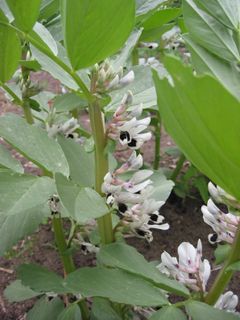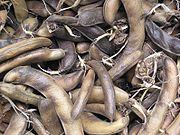Navigation
Scientists Find Why Intercropping of Faba Beans with Maize Increases Yields
Chinese scientists have discovered why an agricultural practice called "intercropping' increases crop yields. The discovery could help farmers cut down the amount of chemical fertiliser they use on their crops, reducing chemical pollution in soils.
See full article and related information on the Horizon Solutions Site: Chinese Scientists Show That Intercropping Maize With Faba Bean Increases Yield
 |
| Vicia faba plants in flower Photo: Wikipedia |
Chinese scientists have discovered why an agricultural practice called "intercropping' increases crop yields.
The discovery could help farmers cut down the amount of chemical fertiliser they use on their crops, reducing chemical pollution in soils.
The practice of intercropping — which Chinese farmers have practised for thousands of years — involves growing two or more crops in alternate rows in the same place and at same time, and can greatly increase grain yields.
In many intercropping practices, legumes are planted with crops. The legumes fix nitrogen in the soils, which then fertilises the crops grown with them.
But other benefits of legumes in intercropping are not clearly understood.
Li Long, Zhang Fusuo and colleagues at China Agricultural University looked at below-ground biological interactions between faba bean and maize. Their research was published last week (3 July) in the Proceedings of the National Academy of Sciences.
They carried out field trials in the western Chinese province of Gansu over four years, and showed that intercropping with faba bean increased the maize yield by an average of 43 per cent.
"The benefits are obvious when they grow together. The underground biological processes play an important role in yield increase," Li told SciDev.Net.
The researchers found that the roots of the faba bean plant released organic acids into the soil, which increases the solubility of inorganic phosphorus, a plant nutrient. Plants take up soluble phosphorus more readily, which explains the increase in the crops' yields.
Enzymes released by the faba bean plant into the soil also decomposed organic phosphorus into an inorganic form, which could then be used by both plants.
 |
| Vicia faba (Tuinboon) ripe seedpods Photograph by Rasbak from Wikipedia |
Faba bean yield increased by 26 per cent due to more available phosphorous, its roots being a different length to those of maize, and the crops having different growth seasons.
The greater yields and more efficient land utilisation resulting from intercropping could be a significant factor in meeting the increasing global food demand, said Li.
 |
| Broad beans, shelled and lightly cooked. Photograph by Richard W.M. Jones from Wikipedia |
Shen Qirong, a professor in plant nutrition at Nanjing Agricultural University, told SciDev.Net that by intercropping, farmers could cut down on the amount of phosphorous fertilisers they use, as intercropped plants have more phosphorous available to them.
Shen said that at present, the "use of phosphate fertilisers is only 15 per cent and the remaining 85 per cent stay in soils uselessly."
Link to full paper in the Proceedings of the National Academy of Sciences
By Xu Jing
13 July 2007
Source: SciDev.Net
Note related information:
Case study on the Horizon Solutions Site: Policy Dynamics and Alley Farming Adoption in West and Central Africa
In the early 1980s, alley farming was developed as an agroforestry practice that is capable of enhancing the sustainability of small-scale farming, the activity of the vast majority of people in the region. The innovation has contributed to soil fertility, enhanced crop production and provision of fodder for animals.
TV program on Integrated Pest Management in China:
At www.horizoninternationaltv.org, IPM_China.wmv
See photographs of faba beans.
Search
Latest articles
Agriculture
- World Water Week: Healthy ecosystems essential to human health: from coronavirus to malnutrition Online session Wednesday 24 August 17:00-18:20
- World Water Week: Healthy ecosystems essential to human health: from coronavirus to malnutrition Online session Wednesday 24 August 17:00-18:20
Air Pollution
- "Water and Sanitation-Related Diseases and the Changing Environment: Challenges, Interventions, and Preventive Measures" Volume 2 Is Now Available
- Global Innovation Exchange Co-Created by Horizon International, USAID, Bill and Melinda Gates Foundation and Others
Biodiversity
- It is time for international mobilization against climate change
- World Water Week: Healthy ecosystems essential to human health: from coronavirus to malnutrition Online session Wednesday 24 August 17:00-18:20
Desertification
- World Water Week: Healthy ecosystems essential to human health: from coronavirus to malnutrition Online session Wednesday 24 August 17:00-18:20
- UN Food Systems Summit Receives Over 1,200 Ideas to Help Meet Sustainable Development Goals
Endangered Species
- Mangrove Action Project Collaborates to Restore and Preserve Mangrove Ecosystems
- Coral Research in Palau offers a “Glimmer of Hope”
Energy
- Global Innovation Exchange Co-Created by Horizon International, USAID, Bill and Melinda Gates Foundation and Others
- Wildlife Preservation in Southeast Nova Scotia
Exhibits
- Global Innovation Exchange Co-Created by Horizon International, USAID, Bill and Melinda Gates Foundation and Others
- Coral Reefs
Forests
- NASA Satellites Reveal Major Shifts in Global Freshwater Updated June 2020
- Global Innovation Exchange Co-Created by Horizon International, USAID, Bill and Melinda Gates Foundation and Others
Global Climate Change
- It is time for international mobilization against climate change
- It is time for international mobilization against climate change
Global Health
- World Water Week: Healthy ecosystems essential to human health: from coronavirus to malnutrition Online session Wednesday 24 August 17:00-18:20
- More than 400 schoolgirls, family and teachers rescued from Afghanistan by small coalition
Industry
- "Water and Sanitation-Related Diseases and the Changing Environment: Challenges, Interventions, and Preventive Measures" Volume 2 Is Now Available
- Global Innovation Exchange Co-Created by Horizon International, USAID, Bill and Melinda Gates Foundation and Others
Natural Disaster Relief
- STOP ATTACKS ON HEALTH CARE IN UKRAINE
- Global Innovation Exchange Co-Created by Horizon International, USAID, Bill and Melinda Gates Foundation and Others
News and Special Reports
- World Water Week: Healthy ecosystems essential to human health: from coronavirus to malnutrition Online session Wednesday 24 August 17:00-18:20
- STOP ATTACKS ON HEALTH CARE IN UKRAINE
Oceans, Coral Reefs
- World Water Week: Healthy ecosystems essential to human health: from coronavirus to malnutrition Online session Wednesday 24 August 17:00-18:20
- Mangrove Action Project Collaborates to Restore and Preserve Mangrove Ecosystems
Pollution
- Zakaria Ouedraogo of Burkina Faso Produces Film “Nzoue Fiyen: Water Not Drinkable”
- "Water and Sanitation-Related Diseases and the Changing Environment: Challenges, Interventions, and Preventive Measures" Volume 2 Is Now Available
Population
- "Water and Sanitation-Related Diseases and the Changing Environment: Challenges, Interventions, and Preventive Measures" Volume 2 Is Now Available
- "Water and Sanitation-Related Diseases and the Changing Environment: Challenges, Interventions, and Preventive Measures" Volume 2 Is Now Available
Public Health
- Honouring the visionary behind India’s sanitation revolution
- Honouring the visionary behind India’s sanitation revolution
Rivers
- World Water Week: Healthy ecosystems essential to human health: from coronavirus to malnutrition Online session Wednesday 24 August 17:00-18:20
- Mangrove Action Project Collaborates to Restore and Preserve Mangrove Ecosystems
Sanitation
- Honouring the visionary behind India’s sanitation revolution
- Honouring the visionary behind India’s sanitation revolution
Toxic Chemicals
- "Water and Sanitation-Related Diseases and the Changing Environment: Challenges, Interventions, and Preventive Measures" Volume 2 Is Now Available
- Actions to Prevent Polluted Drinking Water in the United States
Transportation
- "Water and Sanitation-Related Diseases and the Changing Environment: Challenges, Interventions, and Preventive Measures" Volume 2 Is Now Available
- Urbanization Provides Opportunities for Transition to a Green Economy, Says New Report
Waste Management
- Honouring the visionary behind India’s sanitation revolution
- Honouring the visionary behind India’s sanitation revolution
Water
- Honouring the visionary behind India’s sanitation revolution
- Honouring the visionary behind India’s sanitation revolution
Water and Sanitation
- Honouring the visionary behind India’s sanitation revolution
- Honouring the visionary behind India’s sanitation revolution

